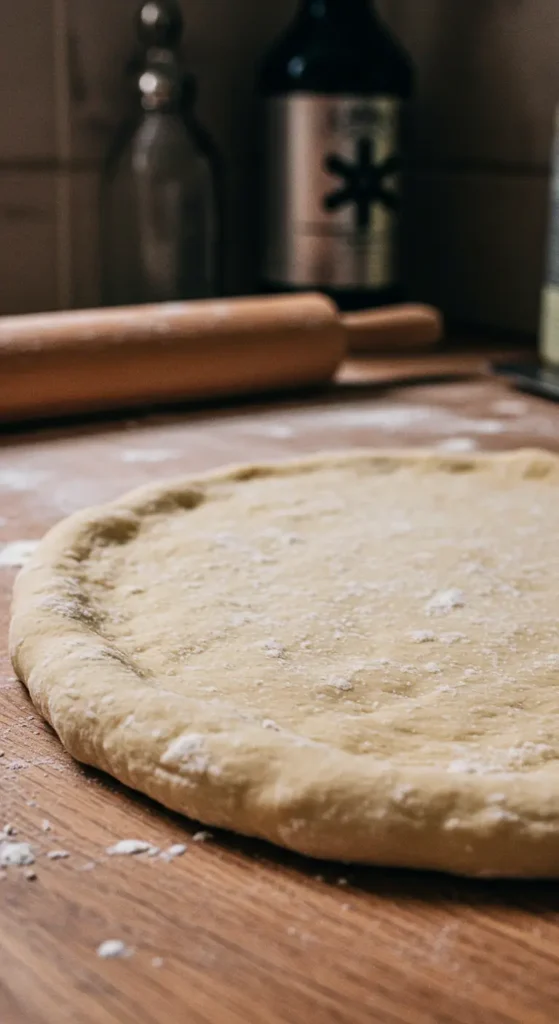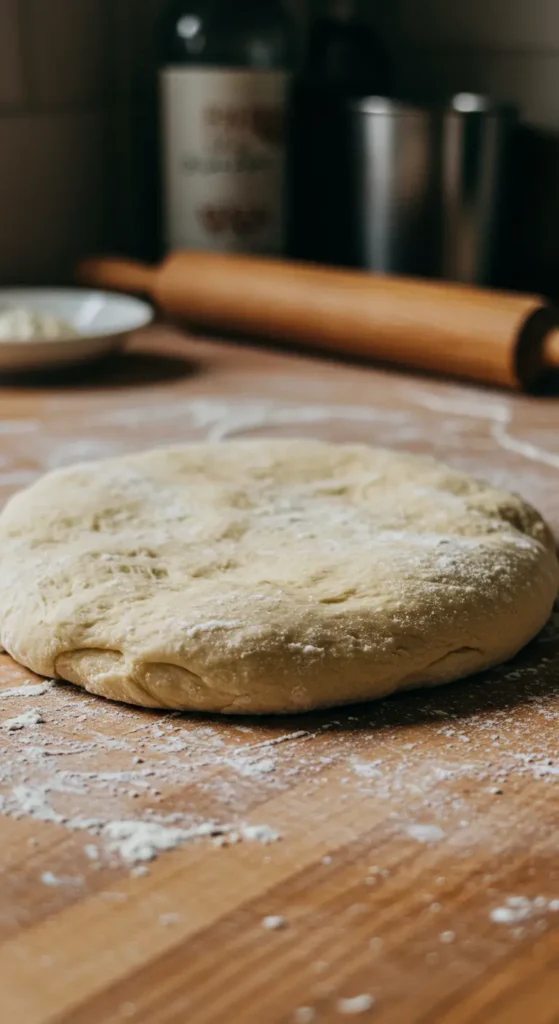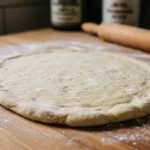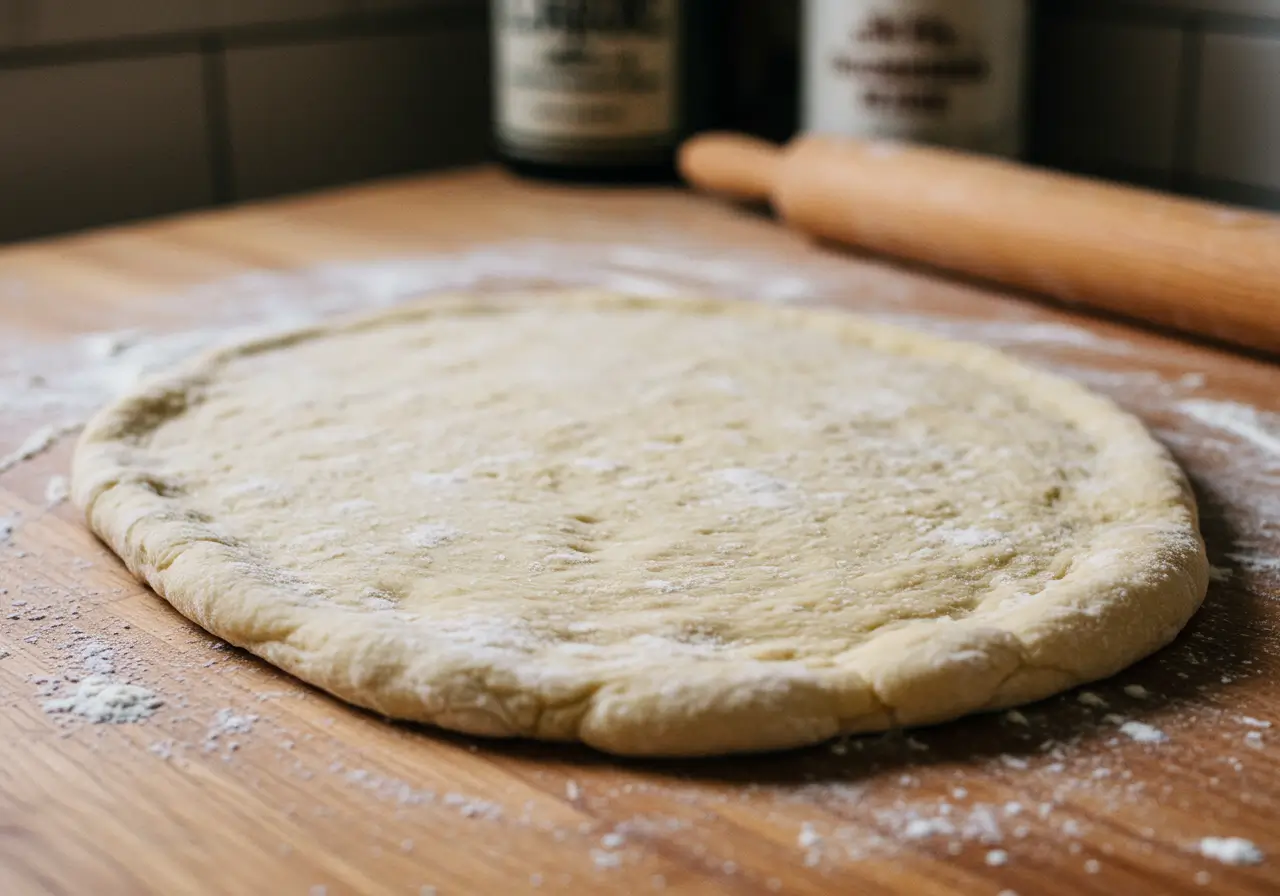Pizza Dough Recipe
Table of Contents
There’s nothing quite like a homemade pizza, fresh out of the oven with a chewy, crispy crust that makes every bite unforgettable. In this guide, we’ll walk through everything you need to know to master the perfect pizza dough recipe. From understanding essential ingredients to troubleshooting dough disasters, you’ll get all the secrets to making pizza nights at home a roaring success. Plus, we’ll sprinkle in expert tips for freezing dough, adding exciting flavors, and choosing your best toppings.
Get ready to roll (pun intended)! Let’s dive right into crafting your dream pizza, one perfect dough at a time.
Essential Ingredients for the Perfect Pizza Dough

Choosing the Right Flour: All-Purpose vs. Bread Flour
When it comes to nailing a pizza dough recipe, choosing the right flour is key. Most home bakers reach for all-purpose flour, and honestly, it works like a charm. It gives your crust a softer, chewier feel — perfect for those who love a bit of a bite.
But hey, if you’re after a crispier, more professional-style crust, bread flour might just be your new best friend. Thanks to its higher protein content, it builds stronger gluten, which means more stretch and more crunch. So, depending on your dream pizza goals, you can’t go wrong with either one!
The Magic of Yeast and How It Works
Ah, yeast — the tiny hero behind every fluffy, bubbly pizza base! Without yeast, your pizza dough recipe would be flat and lifeless. Yeast eats the sugars in the flour, releases carbon dioxide, and poof! You get airy pockets in your crust.
Make sure you use warm water (around 105°F–115°F) to wake up those little yeast cells. Too hot? You’ll kill them. Too cold? They’ll snooze on the job. Instant yeast or active dry yeast both work beautifully, but proofing active yeast first can make your dough even more foolproof. Trust me, it’s worth the extra step!
Step-by-Step Pizza Dough Recipe

Mixing and Hydrating the Dough Properly
First things first — grab a big mixing bowl because things are about to get messy (in the best way!). For a foolproof pizza dough recipe, start by combining your dry ingredients: flour, yeast, sugar, and salt.
Next, drizzle in olive oil and warm water. Stir gently at first, then more confidently as the dough starts pulling together. If the dough’s still shaggy and dry, add a splash more water. If it’s sticky like a swamp monster, sprinkle in extra flour. You want a soft, slightly tacky ball that feels alive under your hands!
Kneading Techniques: By Hand vs. Mixer
Kneading is where the magic really happens. It strengthens the gluten strands, giving your pizza base its chewy, dreamy texture. If you’re using your hands, push the dough away with your palms, fold it back, and repeat.
Want a shortcut? A stand mixer with a dough hook can knead for you in about 5 minutes flat! Either way, you’re aiming for a smooth, elastic ball that bounces back when poked. Kneading right is the secret sauce to a killer pizza dough recipe, so don’t skimp on this part.
First Rise: Creating Airy, Light Texture
Now it’s time to let nature do the heavy lifting. Place your dough in an oiled bowl, cover it snugly, and let it rise somewhere warm.
In about 30 minutes, it should double in size, puffing up like a happy little balloon. This first rise is crucial — it builds the structure and lightness that make homemade pizza better than anything you’ll find at the store.
Pro tip? Don’t rush this step. Good things (and good pizza) come to those who wait!
Common Mistakes When Making Pizza Dough
Using Water at the Wrong Temperature
Oh boy, this one’s a classic slip-up! When following a pizza dough recipe, using water that’s too hot can straight-up murder your yeast. If it’s too cold? Your yeast might just take a nap instead of working its magic.
Stick to warm water, around 105°F to 115°F — like a cozy bath, not boiling lava! Always double-check before mixing it in. Trust me, a simple thermometer saves the day.
Over-Kneading or Under-Kneading the Dough
Kneading is all about balance, and getting it wrong can throw everything off. Over-knead your dough, and you’ll end up with a rock-hard crust that nobody wants to chew through. Under-knead it, and your pizza will bake up flat and dense — not a good look.
Spend just enough time to get a smooth, stretchy dough. It should spring back gently when poked, almost like a little doughy trampoline!
Skipping the Proofing Step
Rushing the rise? Big mistake. Skipping the proofing step robs your pizza dough recipe of the airy, bubbly structure that makes homemade pizza oh-so-good.
Give your dough the time it needs to puff up beautifully. Good pizza is never in a hurry — and neither should you be!
For more delicious recipes and kitchen inspiration, be sure to check out other recipe articles at SmaczneGotowanie.com!
Best Methods to Stretch and Shape Pizza Dough
Hand Stretching Like a Pro (No Rolling Pin!)
Ready to get your hands dirty? Stretching dough by hand isn’t just fun — it’s key to nailing that artisanal look and texture! After your dough rises, plop it onto a lightly floured surface.
Using your fingertips, gently press and push the dough outward from the center, rotating as you go. Don’t rip it! If it fights back, let it rest a few minutes and try again.
Mastering the hand-stretch makes your pizza dough recipe look and taste a hundred times better. Plus, you get those awesome chewy pockets you just can’t roll out with a pin.
Creating a Fluffy Crust with Easy Folding Tricks
Now, for the real magic — the crust! Once your dough is stretched out, pinch the edges slightly or fold them over themselves. This trick locks in extra thickness around the border, giving you a soft, pillowy crust that’s just begging for a garlic butter brush.
No fancy pizza skills needed — just a little fold here and a pinch there, and boom, you’re pizza royalty! A good pizza dough recipe isn’t complete without a crust you actually want to eat first.
Tips for Storing and Freezing Pizza Dough
Refrigeration Methods for Short-Term Storage
Life gets busy, right? Luckily, your pizza dough recipe can work around your schedule! If you’ve got extra dough or just want to prep ahead, pop it into the fridge.
After the first rise, lightly coat the dough in olive oil and seal it tight in a plastic bag or airtight container. It’ll keep happily for up to three days.
Before using, let it come to room temperature for about 30 minutes. This way, it stretches like a dream without fighting you every inch!
Freezing Dough Properly for Later Use
Want even longer storage? Freeze your dough! After the first rise, divide it into portions, oil them up, and wrap them snugly in plastic wrap.
Toss the bundles into a freezer bag, and they’ll stay good for up to three months.
When pizza night calls, thaw in the fridge overnight, then let it rest at room temp before shaping. A smart move for busy cooks who always crave a fresh pizza dough recipe at a moment’s notice!
Variations of Pizza Dough Recipes You Should Try
Whole Wheat Pizza Dough Recipe Variation
Looking to sneak a little extra nutrition into your pizza? Whole wheat flour is the answer!
Swapping half or all of the all-purpose flour for whole wheat creates a denser, nutty-flavored crust that’s full of fiber.
It’s a little trickier to stretch, so add a bit more warm water if your dough feels stiff. With the right balance, you’ll get a hearty base that still rises beautifully, perfect for any homemade pizza dough recipe adventure.
Gluten-Free Pizza Dough Recipe Tips
For our gluten-sensitive friends, good news — gluten-free pizza dough is totally possible!
Use a high-quality gluten-free flour blend designed for baking. Add xanthan gum if your mix doesn’t already include it, as it helps mimic the stretchy texture of gluten.
Gluten-free doughs can be sticky, but don’t panic. Just shape them carefully between two sheets of parchment paper.
Even without gluten, you’ll still end up with a chewy, delicious crust that holds up under your favorite toppings.
Herbed and Flavored Pizza Crusts
Feeling fancy? Infuse your dough with flavor right from the start!
Mix dried herbs like oregano, basil, garlic powder, or even rosemary directly into your dry ingredients.
That way, every bite of your pizza dough recipe will be loaded with bold, herby goodness — no extra work later.
This small twist turns a simple pizza into a gourmet experience without breaking a sweat.
Top Toppings to Pair with Your Homemade Pizza Dough
Classic Margherita Pizza Ingredients
Sometimes, simple really is best. If you want your pizza dough recipe to truly shine, nothing beats a Margherita pizza.
All you need are ripe tomatoes (or a good-quality tomato sauce), fresh mozzarella slices, and a handful of fragrant basil leaves.
A drizzle of olive oil and a sprinkle of salt pull everything together beautifully.
Since Margherita relies on fresh flavors, it’s the perfect match for a soft, chewy homemade crust. Plus, it’s a crowd-pleaser — even picky eaters love it!
Creative and Fun Topping Ideas for Every Taste
Feeling a little wild? Pizza is your canvas!
Try topping your dough with spicy buffalo chicken, roasted veggies, or even a white garlic sauce for a tasty twist.
For veggie lovers, a combo of mushrooms, spinach, and goat cheese never disappoints.
And hey, don’t be afraid to mix sweet and savory — prosciutto with figs and arugula is a total game-changer (just remember, no pork for some diets!).
Whatever you choose, your pizza dough recipe will be the perfect base for all your creative toppings.

Pizza Dough Recipe
- Total Time: PT30M
- Yield: Serves 12 1x
- Diet: Vegetarian
Description
Learn how to create the perfect homemade pizza dough recipe with simple ingredients and easy-to-follow steps. This pizza dough yields a chewy, crispy crust that’s ideal for any pizza night, whether you’re a beginner or an experienced baker.
Ingredients
- 2–2 ⅓ cups all-purpose flour OR bread flour (250–295g)
- 1 packet instant yeast (2 ¼ teaspoons)
- 1 ½ teaspoons sugar
- ¾ teaspoon salt
- ⅛–¼ teaspoon garlic powder (optional)
- ⅛–¼ teaspoon dried basil leaves (optional)
- 2 tablespoons olive oil + extra for brushing
- ¾ cup warm water (175ml)
Instructions
- In a large bowl, mix 1 cup flour, instant yeast, sugar, and salt. Add garlic powder and dried basil if using.
- Add olive oil and warm water. Stir until combined into a shaggy dough.
- Gradually add the remaining flour, stirring until a cohesive ball forms. Adjust flour as needed.
- Lightly flour your hands and form the dough into a ball.
- Drizzle olive oil into a clean bowl, place the dough inside, and roll to coat.
- Cover with plastic wrap and let it rise in a warm place for about 30 minutes until doubled in size.
- After rising, gently deflate the dough and knead 3-5 times on a floured surface.
- Stretch or roll the dough into a 10-12 inch circle.
- Brush the dough with olive oil and poke small holes across the center with a fork.
- Add toppings and bake at 425°F (215°C) for 13-15 minutes until golden and cooked through.
Notes
- Use bread flour for a crispier crust.
- Let dough rest longer for a stronger flavor.
- Freeze extra dough after the first rise for easy future pizzas.
- Let refrigerated dough sit at room temperature before shaping.
- Prep Time: PT15M
- Cook Time: PT15M
- Category: Lunch, Dinner
- Method: Baking
- Cuisine: American
Nutrition
- Serving Size: 1 serving
- Calories: 113 kcal
- Sugar: 1 g
- Sodium: 146 mg
- Fat: 3 g
- Saturated Fat: 1 g
- Unsaturated Fat: 2 g
- Trans Fat: 0 g
- Carbohydrates: 19 g
- Fiber: 1 g
- Protein: 3 g
- Cholesterol: 0 mg
Keywords: pizza dough recipe, easy pizza dough, homemade pizza dough, quick pizza dough, simple pizza dough, best pizza dough
FAQs About Making the Best Pizza Dough Recipe
What Flour Makes the Best Pizza Dough?
When choosing flour for a pizza dough recipe, both all-purpose and bread flour work wonderfully.
If you like a softer, chewier crust, go with all-purpose flour. But if you want a crispy, airy finish, bread flour’s higher protein content is the secret weapon!
How Long Should Pizza Dough Rise?
Timing matters more than you think.
Generally, your pizza dough should rise for about 30 minutes to an hour, depending on the warmth of your kitchen.
It should roughly double in size.
If you want extra flavor, some bakers even let their dough rise slowly in the fridge overnight for an extra tangy punch!
Why Is My Dough Not Stretching?
Stretching woes are super common, but don’t worry.
If your dough keeps snapping back, it probably needs a bit more rest.
Let it sit covered at room temp for 10-15 minutes.
Relaxed gluten stretches way easier, making it simple to shape your pizza dough recipe into a perfect base.
Can I Make Pizza Dough Without Yeast?
Yep, you sure can!
For a yeast-free version, many bakers use baking powder as the leavening agent.
Just know that yeast-free dough won’t have the same airy, chewy texture.
It’ll be more like a flatbread — still delicious, just a little different from classic pizza crusts.

